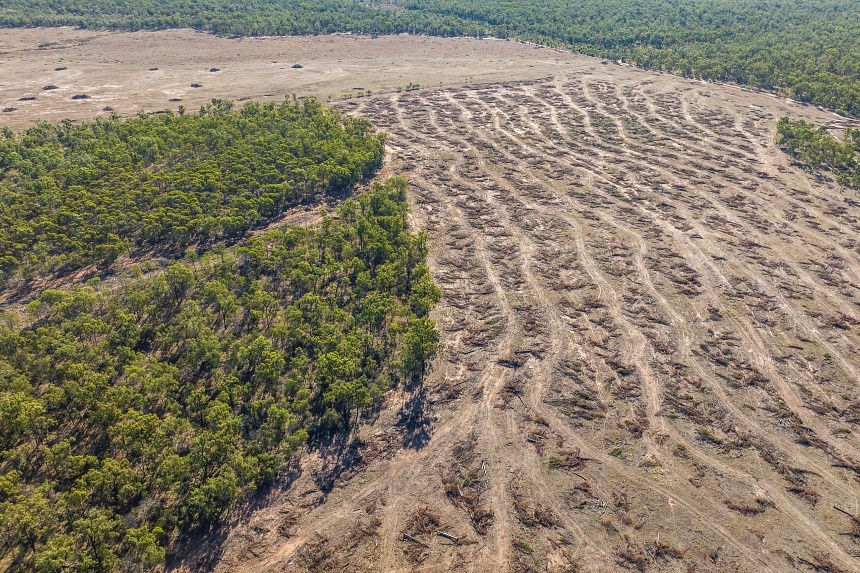SYDNEY – Large-scale deforestation in Australia – mainly for cattle farming – has prompted calls for tougher oversight and incentives for farmers who protect forests, amid concerns about the dire toll on the environment and on threatened species like koalas.
Despite the country backing a United Nations commitment in 2021 to end deforestation by 2030, land clearing is still continuing on a massive scale, especially in eastern Australia.
In the five years to 2023, Australia lost 4.8 million hectares of tree cover, according to the Global Forest Watch website. This was the world’s seventh-largest loss of tree cover, behind Russia, which lost 28.9 million hectares; Canada, which lost 18.9 million hectares; Brazil, which lost 18 million hectares; and the US, Democratic Republic of Congo and Indonesia.
The north-eastern state of Queensland alone recorded clearing of 323,676ha – more than four times the size of Singapore – in the 12 months to June 30, 2022, the most recent year for which data is available.
In New South Wales (NSW), one of the country’s other major offenders, 26,735ha of woodland was cleared in 2021, according to data for the most recent year available.
Such land clearing is damaging and destroying habitats of native species and harming local ecosystems.
Loss of habitat contributed to a decision by the federal government in 2022 to declare koalas an endangered species, and has led to about 100 million animals each year dying or being seriously harmed in NSW and Queensland, according to a study in July commissioned by Greenpeace.
Professor Martine Maron, an expert on biodiversity and conservation science from the University of Queensland, told The Straits Times that laws in Australia were failing to prevent deforestation.
Hundreds of thousands of hectares of regrown forest are cleared each year in Queensland, she said, as well as tens of thousands of hectares of old-growth forest. And, “once it is gone, you can’t get it back”.
“Habitat destruction is the current biggest threat to biodiversity in Australia,” she said. “Clearing vegetation affects soil structure and soil erosion and the water quality in the Great Barrier Reef. Loss of tree cover affects regional rainfall and makes drought worse.”
She noted: “There is a whole suite of environmental impacts that occur from the clearing of native vegetation.”
Deforestation is largely governed by state laws, but state governments are often caught between the need to support the farming sector and protecting the environment.
A study by a University of Queensland researcher published on Aug 20 found that 75 per cent of deforestation cases were allowed to proceed without state assessment under a range of exemptions, such as clearing forests that had been previously cut and were regrowing.
Environmental groups have been pushing major supermarket chains and other large buyers of beef in Australia to stop selling products from deforested farms. Woolworths, one of the country’s two main supermarket chains, announced on Aug 28 that it will make the change from Dec 30.
But farmers in Queensland have objected to reports of widespread land clearing, with some beef producers saying deforestation should be defined only as clearing forests grown before 1990, the year in which the state and federal authorities introduced major vegetation management reforms.
Mr Michael Guerin, the head of AgForce, an association that represents Queensland’s farmers, said that Australia has diverse bioregions and should not adopt a single definition of land clearing, noting that clearing trees in some regions can assist wildlife.
He said the amount and type of land clearing should depend on the specific region’s environmental needs.
“Most of the land clearing in Queensland is not problematic,” he said. “Our challenge to those who seek to vilify us is to think about what is required in each bioregion... If you have one definition, you won’t provide the best environmental outcomes.”
Australia is a major producer of beef and was the world’s second-biggest supplier in 2023 after Brazil, accounting for 14 per cent of global exports.
In the year to June 30, Australia exported A$14.7 billion (S$12.8 billion) worth of beef, including A$3.4 billion to the US, A$2.7 billion to China, A$2.3 billion to Japan and A$2.1 billion to South Korea, and almost A$1 billion to Indonesia, according to a report released by Rural Bank on Sept 10.
Australia had 27.8 million beef cattle as at June 30, 2023, of which 13.2 million were in Queensland and 5.9 million in NSW.
Prof Maron said she believed Queensland and other governments should offer incentives for farmers to protect and maintain forests – such as tax relief or stewardship payments – rather than relying only on regulations that are failing to prevent clearing.
Much of the clearing is captured by satellite after it has occurred.
“We need to see incentives where there are benefits and rewarding of landholders, so it is not just about regulation and punishment, but it is also about rewards,” Prof Maron said.
Australia has one of the worst records of species extinction, accounting for about 35 per cent of the world’s recorded mammal extinctions.
The federal government is seeking to create an environmental protection agency that could have increased powers to enforce environmental laws. The government hopes to pass legislation enabling the agency before the next election, due in May 2025.
Environmental groups have called for the authorities to close loopholes that allow landholders to remove forest from land that has been previously cleared.
Mr Glenn Walker, the head of nature at Greenpeace, said that Australia has “one of the worst rates of deforestation in the world”.
“The rate of hectares bulldozed is on a global scale,” he said.
“Despite attempts at state level to tighten regulations, there remain significant loopholes that mean it continues.”


